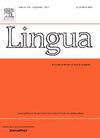特刊导论:世界范围内第二语言英语非标准形态句法变化:基于语料库的研究
IF 1.3
3区 文学
0 LANGUAGE & LINGUISTICS
引用次数: 0
摘要
在过去的几十年里,人们对英语世界中被认为是非标准(即不属于标准书面英语的共同核心)的形态句法特征的分布进行了大量的实证研究。通过启发方法(访谈和问卷调查)、方言语料库和开放获取的在线地图集获得了见解。然而,目前缺乏大规模的基于语料库的研究,这是本期特刊试图解决的问题,撰稿人从语料库中提取数据——主要来自英语口语录音,在某些情况下是最近编纂的——主要代表“新英语”(本土化的国家第二语言品种,在英语被确立为重要语言的“外围”国家使用,尽管英语不是大多数人口的母语)。大多数贡献采用宏观方法,研究广泛的第二语言英语变体中的一组特征,但有些采用微观方法,将注意力集中在单个特征或少量特征上。本文章由计算机程序翻译,如有差异,请以英文原文为准。
Introduction to the Special Issue: Non-standard morphosyntactic variation in L2 Englishes world-wide: corpus-based studies
Over the last few decades, a good deal of empirical research has been conducted on the distribution in the English-speaking world of morphosyntactic features considered to be non-standard (in the sense of not being part of the common core of standard written English). Insights have been achieved using elicitation methods (interviews and questionnaires), dialect corpora and open-access online atlases. There is, however, a dearth of large-scale corpus-based research, one that the present special issue seeks to address, with contributors drawing data from corpora – mainly derived from recordings of spoken English, and in some cases recently-compiled – representing mostly “New Englishes” (indigenised national L2 varieties, spoken in “outer circle” countries where English is established as an important language, even though it is not the native language of the majority of the population). Most contributions adopt a macro approach, investigating a set of features in a wide range of L2 English varieties, but some adopt a micro approach, zeroing in on a single feature or a small number of features.
求助全文
通过发布文献求助,成功后即可免费获取论文全文。
去求助
来源期刊

Lingua
Multiple-
CiteScore
2.50
自引率
9.10%
发文量
93
审稿时长
24 weeks
期刊介绍:
Lingua publishes papers of any length, if justified, as well as review articles surveying developments in the various fields of linguistics, and occasional discussions. A considerable number of pages in each issue are devoted to critical book reviews. Lingua also publishes Lingua Franca articles consisting of provocative exchanges expressing strong opinions on central topics in linguistics; The Decade In articles which are educational articles offering the nonspecialist linguist an overview of a given area of study; and Taking up the Gauntlet special issues composed of a set number of papers examining one set of data and exploring whose theory offers the most insight with a minimal set of assumptions and a maximum of arguments.
 求助内容:
求助内容: 应助结果提醒方式:
应助结果提醒方式:


